Project: Glowworm in love
Inspiration and Concept
In this project, we combine the human body structure with the glowworm, and exaggerate the characteristics of the body parts such as the spine and hips, to develop the design of an original wearable interactive device and show the animal nature that humans have, especially in the courtship process.
The inspiration for this project comes from Selfish Genes. In this book, Dawkins examines childbearing as an evolutionary strategy, arguing that our genes would guide us to choose the spouse that can best reproduce their offspring. Based on this theory, we try to think about what might affect people’s choice of their spouse from both explicit and implicit perspectives. In terms of direct behavior and appearance, it occurred to us that humans signal attraction by showing the curves of their bodies or by gesturing with their eyes. This reminds us of fireflies: this insect attracts its partner at night by flickering its tail. This is the reason why we modeled it with both the buttocks and the flickering feature enlarged. And from a recessive perspective, or from a genetic, we found the research paper by Dewan MC about the influence of pregnancy on women with adolescent idiopathic scoliosis, which concludes that Nulliparity rates were slightly higher among AIS patients, and more frequent infertility treatment was required. Pregnancy-related back pain was common, and while non-disabling, may have been more severe than in healthy women.
And another research talks about how this alternation in the spine, Scoliosis, as a triplanar deformity can impact the gait pattern. This research study concludes that scoliotic subjects have a slower speed of gait due to a shorter stride length and a longer stride time, together with variations in the timing of muscle activation.
So the general logic about this project is that the person wearing this wearable is trying to attract others like an original animal, but at the same time, she is also examined by others in the way that she walks, which also shows the animal nature or the gene that is embedded in human beings. The brain instinctively tells the other whether she is suitable for reproduction or not, which then leads to the judgment of whether she is suitable to be one’s spouse or not. It shows how vulnerable people are in terms of making their “own decision”. Human beings are in fact heavily affected by the genes they have which are out of our control. Different from past work by others in the field, we do not want to express the criticism of the almost primitive charm and natural selection in the process of choosing a spouse, but we want to arouse people’s deeper reflection on love or human characteristics: what makes people tick, and what do people think about besides animal nature? By showing the animalistic nature of human beings that is engraved in their genes, especially in the process of choosing a mate, this work will cause people to think about human nature from the opposite perspective.
Design ideas
We followed the design of hair bands and collars in previous projects 1 and 2, using pressure sensors as the trigger for the whole mechanism. the model pressed the sensors behind her ears to make a flirtatious gesture similar to ruffling her hair, showing her willingness to court, while also triggering the swing of the spine behind her and the flashing of the tail fiber, making the expression of her willingness more distinct.
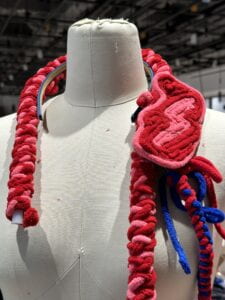
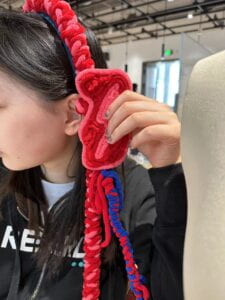
In order to show the hard armor of glowworms and human skeletons, as well as the romantic emotions of human beings, we used a combination of two materials, 3D printing, and wool, to achieve the coexistence of hardness and softness.
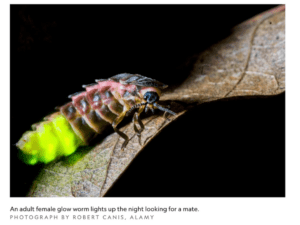
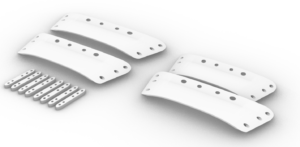
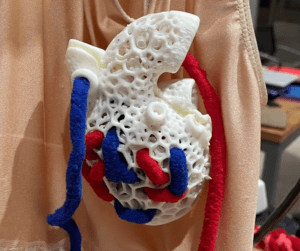 For the sake of unifying colors, we reduced the colors of wool to three: red is the artery, blue is the vein, and pink refers to romantic feelings.
For the sake of unifying colors, we reduced the colors of wool to three: red is the artery, blue is the vein, and pink refers to romantic feelings.
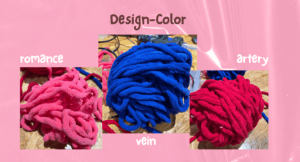
Because this project aims to show the animal side of human genetics, we wanted to make the whole installation a part of the human body, just like human skin would have been, and make it natural. Therefore, we chose a skin tone primer. At the same time, considering that the models had to actually wear it for the school runway, we changed the design several times, adding more designs on the chest and the lower half of the body to enhance its feasibility.
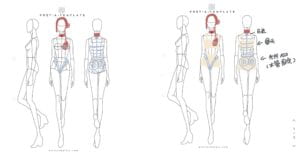
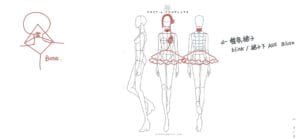
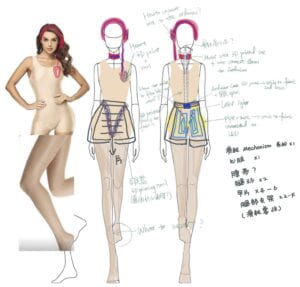
Process
- Heart
We changed the heart previously knitted with wool into a 3D printed heart, using the hole in the middle of the heart and adding red and blue wool between them to represent veins and arteries, hoping to show the effect of both hardness and softness. In the actual printing process, we chose to print the whole heart for the first time, but because of the excessive number of holes and the amount of support needed, we found it difficult to separate the support from the heart itself. So we split the heart into two halves and then glued them during the knitting process.
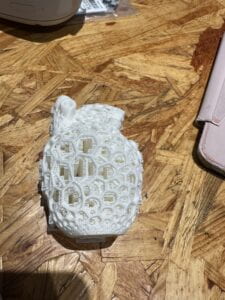
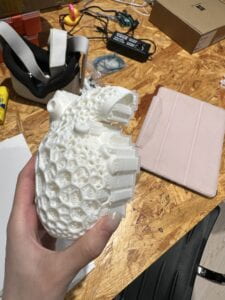
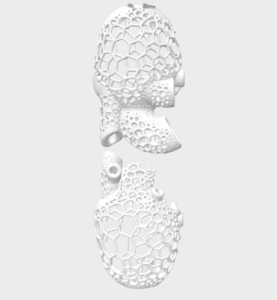
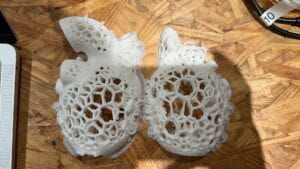
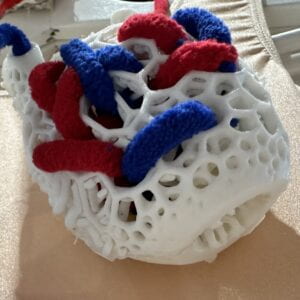
- Spine
Everything went smoothly during the Prototype process, and we managed to 3D print the spine and take down the support and the mechanism went well.
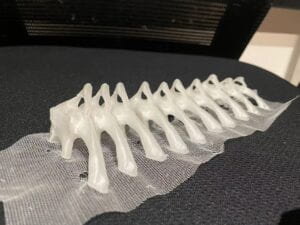
But when we tried to print more at the same time, we found that the 3 columns of bones were a bit too small for the printer and the support itself was not solid enough. So we reduced it to 2 columns and enlarged the size of the bones. However, during the adjustment process we did not notice that the bases of all the bones were not in fact at the same level, which meant that there were some parts of the bones that we could not remove the support part. So we had to reprint them after another adjustment.
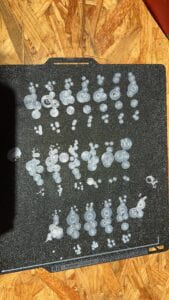
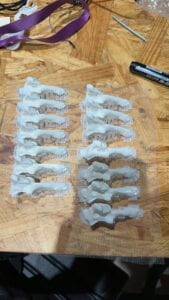
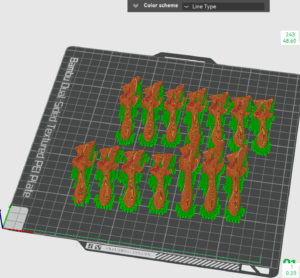
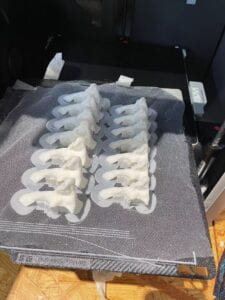
Because the 3D printing process is actually very unstable, and sometimes it inexplicably breaks down, we don’t want to waste any of our relatively intact pieces. We made those relatively imperfect parts into belts, making them the dividing line between human features and insect features. Because of the large size of the bones, we had no way to put them on a sewing machine to work, so we did the sewing by hand.
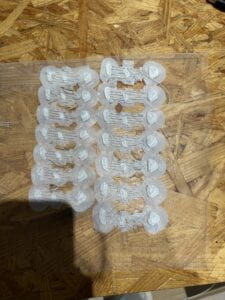
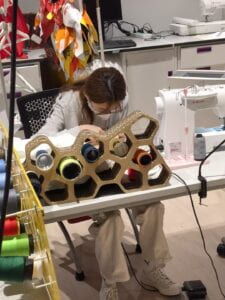
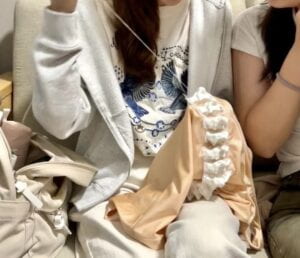
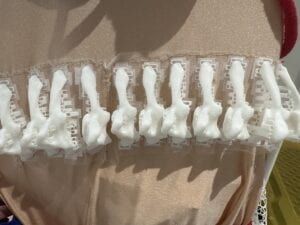
We tested the last bone that printed most successfully as our spine. In Project 2, we tried the Peaucellier-Lipkin Inversor, but when it came to the actual installation we found that we had no place to fix our slides. As well as the previous motor movement was not effective mainly because the fan blade on the motor was easy to fall off. I found the right size pegs to hold it in place, and the result was instantly better.
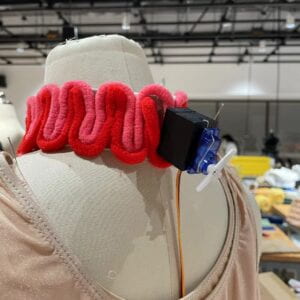

- Hip
In Project 1, we used a thin fiber optic to wrap around the water pipe for fixing. The problem we encountered at that time was that the LEDs did not fit tightly into the water pipe to provide light and the process of threading the water pipe outside the fiber was difficult.
We have improved this in the final project. First we changed the size of the fiber and bought a larger diameter fiber (6mm) and a corresponding size 5v LED, and we made two attempts to fix it on our “skin”. The first attempt was to punch a hole in the fiber and then use screws to fix it. The problem was that the cutoff in the middle of the fiber would reduce its ability to conduct light. So we gave up this option and chose to use a water pipe to fix it. Unlike the last time, we used a small cut of water pipes this time and fixed them with a needle and thread in the bend part to make them less obvious.
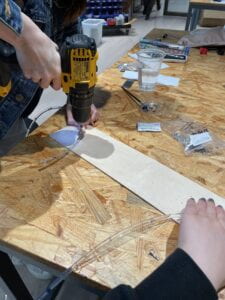
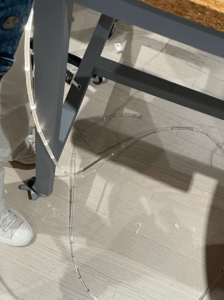
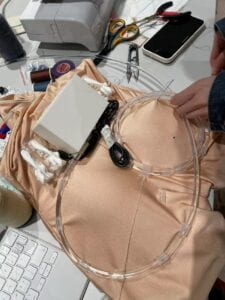
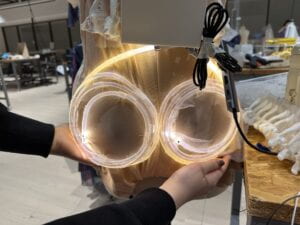
We also modified the code so that the pressure sensor becomes a trigger for the fiber to light up instead of controlling its brightness directly.
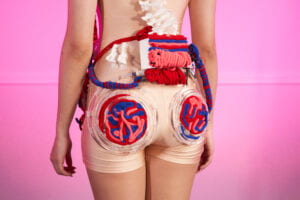
Code:
#include <Servo.h> //header for controller servo Servo myservo; //keeping name of servo SERVO itself int pos = 0; int sensorvalue = 0; int s_pin = A0; void setup() { // initialize serial communication at 9600 bits per second: Serial.begin(9600); pinMode(s_pin,INPUT); pinMode(9,OUTPUT); pinMode(6,OUTPUT); pinMode(11, OUTPUT); //PWM output to servo myservo.attach(11); } // the loop routine runs over and over again forever: void loop() { // read the input on analog pin 0: int sensorValue = analogRead(A0); int newValue = map(sensorValue,0,1023,0,255); // print out the value you read: Serial.println(sensorValue); if (sensorValue > 50){ digitalWrite(9,LOW); digitalWrite(6,LOW); } else{ digitalWrite(9,HIGH); digitalWrite(6,HIGH); moveServo(); } delay(1); // delay in between reads for stability } void moveServo() { for (pos = 30; pos <= 150; pos += 1) { // goes from 0 degrees to 180 degrees // in steps of 1 degree myservo.write(pos); // tell servo to go to position in variable 'pos' delay(10); // waits 15 ms for the servo to reach the position } for (pos = 150; pos >= 30; pos -= 1) { // goes from 180 degrees to 0 degrees myservo.write(pos); // tell servo to go to position in variable 'pos' delay(10); // waits 15 ms for the servo to reach the position } }
- Box
To store our wires and motors, we printed 2 boxes and punched holes in them so that we could secure them with wires. But the waist box we underestimated the size of the cords, especially the USB cable, so we ended up having to pin them to our waist and put the rechargeables in our lap. For aesthetic purposes, we wrapped them with wool to make them look less abrupt.
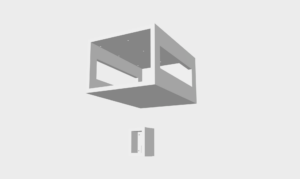
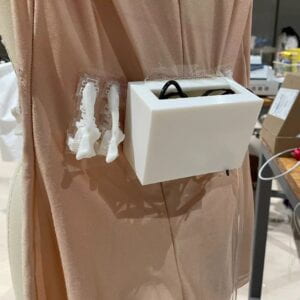
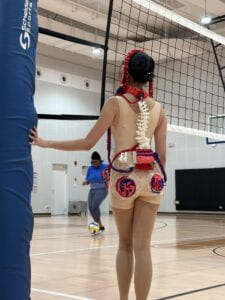
- Armor and Wool Design
The armor on the abdomen, the chest and the pattern design on the hips are the last parts of our production. The intent of these designs was to protect the model and hide the traces of underwear. We originally designed the abdominal armor to be covered with interlocking wool, but to add more insect elements and to meet our animalistic theme, we combined the insect abdominal design and modified the puppy armor model (Don’t tell Jade about this—-) to create our current belly armor. And because the white model is too monotonous and the overall design does not fit, we added the element of wool. Because of time constraints, this part of the design I think there is still a lack. Improvement will be highlighting the belly armor, so that the wool becomes an accent. The pattern on the chest and hips is intended to echo the design of the upper body, reflecting the concept of romantic and complex emotions through the interplay of different colors of wool.
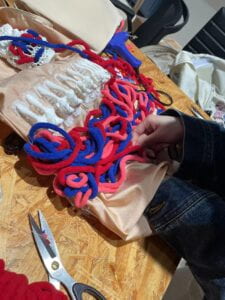
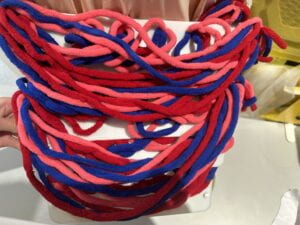
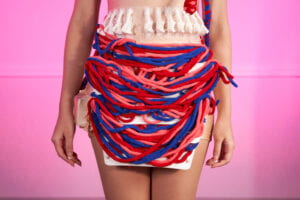
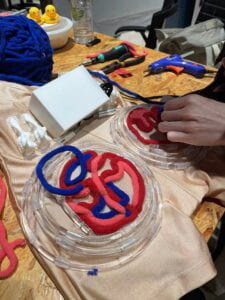
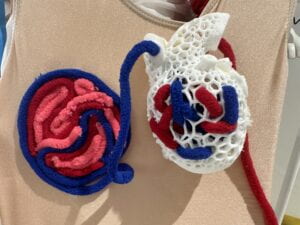
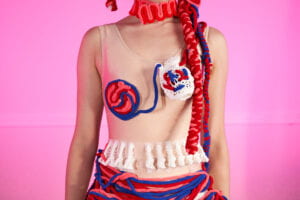
Final Result
We finally got everything done right before the IMA show and the mechanism went well (that is I have never supposed). Thanks for the support and help from my partner Younian and our dear Marcela. And our model Jade looks fantastic that night. She is sooooo cute 😭 The Runway show was almost a miracle for me, and it was one of the best nights I’ve had in a while. I was close to tears the moment Jade stepped on the runway. We did it!
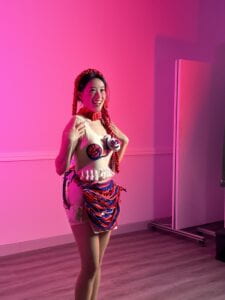
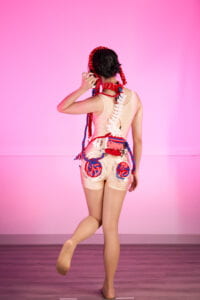
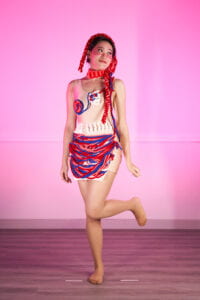
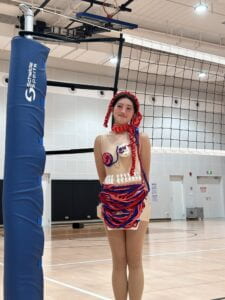
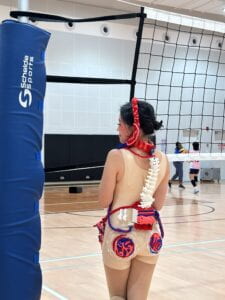
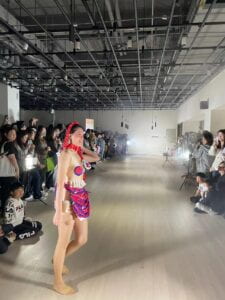
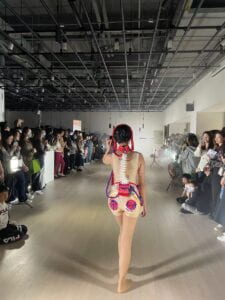
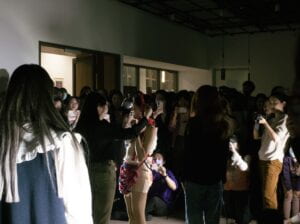
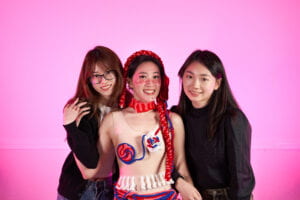
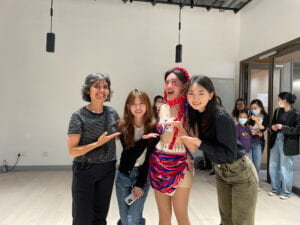
Limitation and Further Improvement
- The swing of the spine is not so obvious on the runway, perhaps after we need to enlarge the amplitude of motor movement
- The design of the armor needs further improvement, perhaps we should change the lower decoration to a skirt or the abdominal armor is also printed on the fabric to make it more closely fit the body curve
- The placement of wires and rechargeables is a problem, and a larger box might be better
Labor Division
I started work first because Younian was sick for a few days at the beginning of the project. We basically shared all the work equally such as the overall design, fiber optic fixation, model support disassembly, and armor part of the wool weave. If we have to tell the difference in distribution, I would say I did more sewing and took care of the coding and circuit connections, as well as designing our storage box. But most of our work is done together, and there is no division of labor where one person is responsible for a particular part. This is the second time I’ve worked with Younian on a project and she is the best team member I’ve ever met. I really enjoy working with her and we really help support each other ❤️
References
Dawkins, R. (2006). The Selfish Gene. Oxford University Press.
Dewan MC, Mummareddy N, Bonfield C. The influence of pregnancy on women with adolescent idiopathic scoliosis. Eur Spine J. 2018 Feb;27(2):253-263. doi: 10.1007/s00586-017-5203-7. Epub 2017 Jun 29. PMID: 28664223.
Haber, C.K., Sacco, M. Scoliosis: lower limb asymmetries during the gait cycle. Arch Physiother 5, 4 (2015). https://doi.org/10.1186/s40945-015-0001-1.
Peaucellier–Lipkin linkage
https://en.wikipedia.org/wiki/Peaucellier%E2%80%93Lipkin_linkage
Picture:
Model:
Heart: https://www.thingiverse.com/thing:2704299
Armor: https://www.thingiverse.com/thing:4813609
Spine: https://www.thingiverse.com/thing:4801717